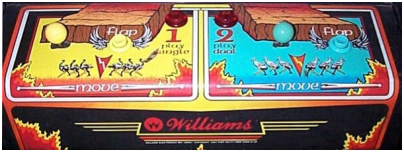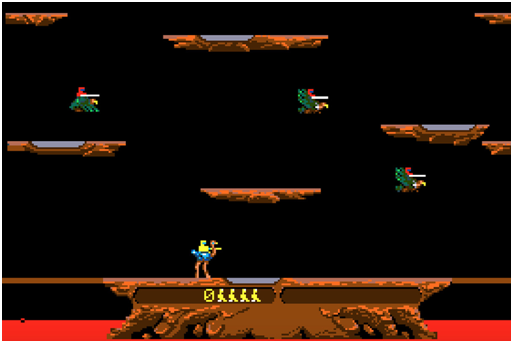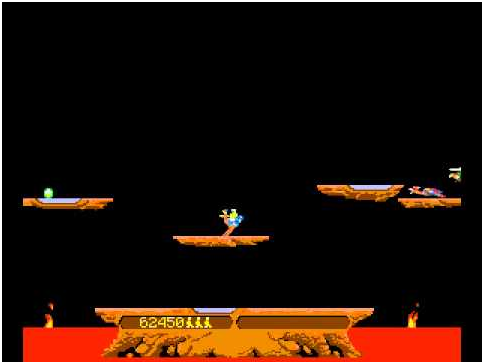Some of the most iconic video games came into being back in the late ‘70s & early ‘80s, with a plethora of hits finding their way to the market at that time. With amazing titles such as Space Invaders, Asteroids, Pac-Man, Defender, Donkey Kong, Galaga, Ms. Pac-Man, and Dig Dug, among many, many others, it’s no wonder we call this period of gaming the “Golden Age.”
Among these iconic games is Williams’ Joust. This unique title offers thrilling and high-speed action in either co-op or competitive settings, making it among the first arcade titles to feature cooperative gameplay where two players can collaborate on one machine to achieve a common goal. The game is set in a jousting tournament where the last two knights are left to fight against hordes of enemy riders. To this end, the heroes must hop on their powerful bird mounts, and compete to survive in the arena for as long as they can.
Joust features an interesting combat system where, instead of shooting at enemies like so many space shooters of the time, the objective is to run into your opponents while being at a greater height than them, in order to dismount them with your jousting lance. However, this game has a rudimentary physics-based movement system where your birds gain momentum and take time to stop, and to gain and lose height when using your bird’s powerful wings. In this sense, matches typically consist of running back and forth across the ever-wrapping stage, trying to dismount everyone while avoiding getting knocked from your mount yourself.
With that being said, on this occasion, we’re going to share some useful info, tips, and tricks to getting good at Joust.
The Basics
As we mentioned above, Joust doesn’t have much in the way of active combat, as the only way of defeating your enemies is to run into them while at a greater height than them. In this sense, each player only has two controls: A joystick used to move either left or right across the arena, and a “Flap” button which, when mashed, controls your bird’s wings, allowing them to gain height before running into enemies, or for reaching higher platforms on the arena. Later on, the button can also be mashed to escape the grasp of Lava Trolls, environmental hazards that appear on later waves.

The enemies in Joust are all very similar in appearance, consisting of mounted fighters, just like the player. However, while they may look alike, they do NOT behave similarly:
- Bounder: The very first type of enemy you encounter in the game, worth 500 points. Bounders mostly run in one direction and don’t necessarily actively try to dismount you. Nevertheless, they can be quite tough to deal with when the stage is full of these enemies.
- Hunter: Fast enemies that have better control over their birds, worth 750 points each when defeated. Hunters live up to their name with their behavior, often changing directions to actively pursue the player. Quite dangerous, but not very tough as they’re still easy to outmaneuver.
- Shadow Lord: The most unrelenting enemies in the game, worth 1,500 points when defeated. Shadow Lords not only actively hunt the player at all times, but they also ignore some of the game’s physics, being able to fly and change directions in mid-air much better than they player’s birds can. The best way to deal with them is simply to charge them head-on and jump at the last second to gain the high ground.
- Pterodactyl: An exception to the other mounted enemies, that start appearing whenever you take too long to clear a wave. These enemies spell instant death for you if they touch you. And while they can be killed, it’s very difficult to do so as you must aim your lance directly into their open mouths. Pterodactyls often fly around as long as there are enemies or eggs left on the stage. As soon as you deal with the other hazards, they will simply fly off the screen and go away.
One very important aspect about the enemies is the fact that, with the exception of Pterodactyls, all of them drop eggs when defeated. These eggs can be picked up for bonus points, though the main reason why you want to do this is because, after some time, the eggs will hatch into an enemy of a higher tier than the one who dropped it. In other words, Bounder eggs will hatch into Hunters; Hunter eggs will hatch into Shadow Lords, and Shadow Lord eggs will hatch into another Shadow lord.

It goes without saying but, pick up as many eggs as you can as these can and will throw a wrench into your plans if left unchecked. This goes for most occasions, unless the times when picking up an egg would cause you to lose a life. In these cases, it’s better to just suck it up and deal with the enemies that hatch from them. It’s worth mentioning, however, that there’s a short period between when the egg hatches and when the newborn enemy hops on their mount, where you can still run over them to prevent them from entering combat.
Wave Types
As you clear waves and progress through the session, enemies will progressively get tougher. Specifically, Bounders start off slower than your mount, and then speed up to match your own bird through the first few waves. Afterward, Bounders get replaced by Hunters; Hunters by Shadow Lords, up until all enemies spawn as Shadow Lords from wave 37 and onward, with a few exceptions. After wave 60, however, all enemies are Shadow Lords without exceptions.
However, while the standard waves become increasingly difficult, there are also a couple of special wave types that can shake up the gameplay quite a bit, including the following:
- Egg Waves: 12 eggs spawn strewn through the arena in wave 5, and then every 5 waves after that. These waves are as easy as they sound; simply pick up all the eggs to win. However, if you’re seeking to max out your score at the risk of losing lives, then you can let the eggs hatch and deal with the emerging enemies.
- Pterodactyl Waves: From wave 8, and then on every fifth wave after that, the regular enemies will spawn alongside a few Pterodactyls from the very beginning, which will put more pressure on the player as they must juggle eliminating the enemies while also avoiding (or killing) the flying menaces. The first Pterodactyl waves start with only one of these beasties, though the ones in later levels can spawn up to three of them from the very start.

Like with most games of the time, mastering Joust is all about practicing, especially when it comes to mastering the movements. However, with the tips and info we’ve shared in this brief overview, you’re ready to face the challenges with a head start. Happy hunting!
Thanks for reading! Here at PrimeTime Amusements, we like to keep ahead of the curve in arcade game rental and sales and pride ourselves in providing the best service in the country. If you’re looking for a game in particular, or have a few questions about the industry, feel free to give us a call at 1.800.550.0090 or to swing by at 5300 Powerline Rd. Suite 210, Ft. Lauderdale, Florida, 33309.





